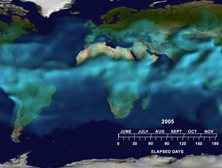Many Texans – especially those living near the state’s Gulf Coast – know just about everything they care to know about humidity, the amount of water vapor in the air.
That’s not true for climate scientists working to improve their understanding of human-caused warming of the earth’s atmosphere and the other resulting changes in climate.
Changes in water vapor are regarded as the largest feedback mechanism in the climate system affecting its sensitivity.
Carbon dioxide and other greenhouse gases from human activities are warming the atmosphere. With higher temperatures, more water evaporates. More water vapor in the air leads to higher temperatures, causing still more evaporation.
Computer models simulating and projecting climate changes caused by greenhouse-gas emissions incorporate this water vapor cycle as a factor enhancing manmade global warming.
Scientists have improved their understanding of water vapor’s role in recent years, but a shortage of experimental evidence meant there was lingering uncertainty about about just how big a factor it is.
A study by scientists at Texas A&M University has now confirmed that water vapor’s heat-boosting effect is powerful.
“We now think the water vapor feedback is extraordinarily strong, capable of doubling the warming due to carbon dioxide alone,” Andrew Dessler, a professor in A&M’s Department of Atmospheric Sciences, said in a statement issued by NASA.
The research project by Dessler and colleagues used data from a NASA satellite to take precise measurements of humidity through the lowest 10 miles of the atmosphere.
“Everyone thought the models were right, but recognized they didn’t have the evidence they should, considering how important (water vapor) is,” Dessler told Texas Climate News.
Other efforts have been made to test the models, but the A&M study assembled the best measurements to date, he said.
Next, Dessler plans to study the response of clouds in climate change – one of the major uncertainties occupying climate scientists.
– Bill Dawson

